With Sabretooth as his father, how could he become anything but a bad boy?

"(In 1974) I suggested to (writer) Len Wein, over lunch, that I thought it was time we had a Canadian hero," recalled then Editor-in-Chief at Marvel Comics, Roy Thomas, in The X-Men Companion. "There was talk about names like Captain Canuck, Captain Canada, things of that sort, and I suggested that since we had a Canadian market and I felt guilty about not having more Canadian characters in the comics, the X-Men should have a character that I suggested be called the Wolverine because that animal inhabits Canada as well as the Northern United States and would be familiar to both. He could be a Canadian and be very fierce. I was thinking of someone much like what evolved, a very fierce character worth his weight in wildcats, that kind of thing."
"And he should be short, because wolverine's are small, and they're very fierce," Thomas added in Comics Creators On X-Men. "After that, Wolverine was all Len working with John Romita, who designed the character."
"Roy suggested, "Do a character called Wolverine," gave him to me to create for the Hulk, and most of the rest of the details as to who and what he was were my own," Len Wein recalled in The X-Men Companion. "So I decided to make him a teenage mutant, to be one of the new X-Men if it came to pass."
"He was a mutant only in terms of his ferocity and his animal senses. He was a hunter and a tracker and incredibly resilient. He was able to get the stuff kicked out of him by the Hulk and still be able to get back on his feet."
A mutated wolverine
Len Wein described Wolverine's personality in The X-Men Companion: "Like the personality of a wolverine, snapping, nasty, aggressive, not a nice person. Heroic, because that's his bent, that's what he's after, but not a nice guy. He's tough, savage and a fighter."
"He has to fight to control himself, but what would make him a hero in my vision of him was that he would be able to overcome his natural instincts to slit your throat. That was what really would make him a hero, not his abilities to beat you up. The fighting was what he lived for."
"As far as his origin goes, originally we had intended to have him be a mutated wolverine," artist Dave Cockrum revealed in The X-Men Companion.
"There were remarks in the storyline at one point where somebody was assessing Wolverine and saying, "I'm not even sure if he's human," or something like that (in X-Men #98, 1976), which would have led up to it," Cockrum added in Wizard Tribute To Wolverine.
"The first origin that was concocted, was that he was actually a mutant wolverine, boosted up to human form by the High Evolutionary," subsequent artist John Byrne revealed in The Comics Journal #57. "Okay, that works except that (writer) Archie (Goodwin) did a similar number in the first Spider-Woman story. And no matter how things have changed in that strip since, the idea has been done before so we dropped it."
Cockrum revealed in Wizard Tribute To Wolverine that the idea also met with editorial resistance: "Stan Lee found the concept disgusting."
"The claws were retractable, but into the gloves," Wein noted in Back Issue #4. "I guess it was Dave and (subsequent writer) Chris Claremont's idea to make them part of his body."
"Dave said Len thought the claws were in the gloves and he and I both agreed, "Why?" If they're in the gloves, then anybody could wear the gloves," Claremont told Back Issue #4. "We needed something that made him a mutant, something that made him unique. The claws were obviously artificial, and if the claws were part of the glove, what made him a mutant? The reductium of the equation was what makes him a mutant is the healing factor. But if he has a healing factor, what about the claws? Well, let us make the claws part of him. The healing factor enables him to survive with the claws. Dave and I thought, "This is cool, we'll run with it."
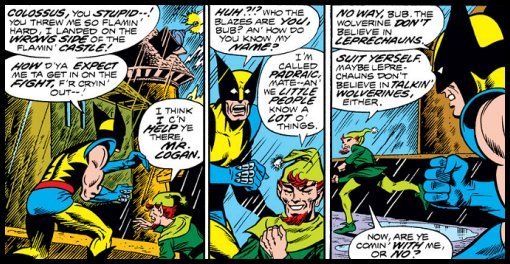
The first unresolved plot
"Len thought Wolverine was 19 years old," Claremont told Back Issue #4. "Dave is the one that came up with the look, the hairline. (...) The way Dave drew him, he looked older. As I wrote him more and more, he felt older."
"It just seemed in my mind to fit the character, the notion that he's been around a long time," John Byrne noted in Back Issue #4. "I got to thinking he looks pretty rough and tumble for a guy who has a healing factor. Maybe he's been around a long time."
"The over a century old was something that was decided later on," Claremont added in Back Issue #4. "You gradually build the structure of the character."
"(Writer) Roger (Stern) and I have a Captain America story we'd like to do, guest-starring the X-Men, where Cap will be talking to a couple of them, and Wolverine is real quiet at first," Byrne revealed in The Comics Journal #57. "And when he finally speaks, Cap will do a take and say, "Corporal Logan?" Because, you see, Cap met him during the war. And that might be the first time in one of the books we come out and say just how old this guy is."
Stern and Byrne left Captain America before getting around to doing this story, though, so it wasn't until Uncanny X-Men #268 in 1990 that Claremont wrote a similar story revealing Captain America and Wolverine's history.
The first unresolved X-Men plot arose in X-Men #103, 1977. At Cassidy Keep in Ireland, a leprechaun that knew his real name was Logan surprised Wolverine. Wolverine asked how the leprechaun knew his hitherto unrevealed name, but the question remained unanswered.
Claremont told Back Issue #4 that the name Logan was inspired by Mount Logan, a mountain in Canada. "The idea was the tallest mountain being the name of the shortest character."
"Chris and Dave had said quite openly they could never figure out what to do with Wolverine," Byrne revealed in Back Issue #4. "Dave's favorite character clearly was Nightcrawler. When I started, Chris was still conferring with Dave on the plot, and I was really just the art robot for the first two or three issues, until finally I just protested and said, "Excuse me, it's not Dave's anymore. And Chris told me at one point, "We're going to write Wolverine out because we don't know what to do with him. And I stamped my little foot and said there is no way you're writing out the only Canadian character. And so I made him mine. Whenever I do a group book I make one character mine and sort of focus on that character so I have a focus for the book."
"Even though I didn't like him and I didn't know exactly what to do with him, I don't think we were ever thinking about actually removing him from the book," Cockrum contradicted in Comics Creators On X-Men.
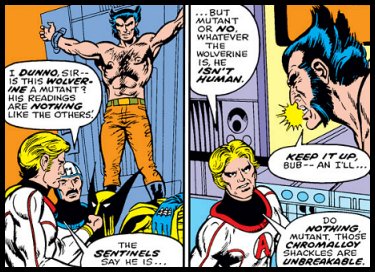
Wolverine's father
"When I did Iron Fist #14 (1977), I had done a design for what I thought Wolverine looked like without his mask on, which I sent to Chris," Byrne recalled in Back Issue #4. "And Dave had already done one, which I didn't know about. And I ended up using that design for Sabretooth."
"And that sort of planted little things in my head, and then I got to thinking about that storyline, that typically Chris throwaway line in that Sentinels story (in X-Men #98, 1976) in which the Sentinels said Wolverine was a mutant and a technician said he wasn't. And I suggested that Sabretooth was his father and that Sabretooth was the mutant and that the mutation had bred true. So Wolverine was actually the first of a new species, and that's why it confused the technician. Then we got to playing about how Wolverine is 50 years old and Sabretooth is 100 years old."
"His mother was a Native Canadian and he'd lived up in the mountains for most of his life, feral, until he was found by James Hudson," Byrne added in Comics Creators On X-Men.
"I was never entirely sure whether Wolverine would ever learn for himself that Sabretooth was his father," Byrne said in Back Issue #4. "I thought that perhaps Sabretooth would know, but that Wolverine himself might not ever know."
Although the confusion on the technician's side was probably just caused by the claws hidden inside Wolverine, the idea of Sabretooth being his father stuck around. "John Byrne and I had a storyline that would have established Sabretooth as Wolverine's father," Claremont confirmed in Wizard Tribute To Wolverine. "And that was a thread that I ran through the series for my entire tenure. The whole point of the birthday party story in Wolverine Vol.2 #10 (1989), my last issue, was to establish that pretty much every year on his birthday he gets hunted. And every year he has lost. I also did it in a back-up story in Classic X-Men #10 (1987)."
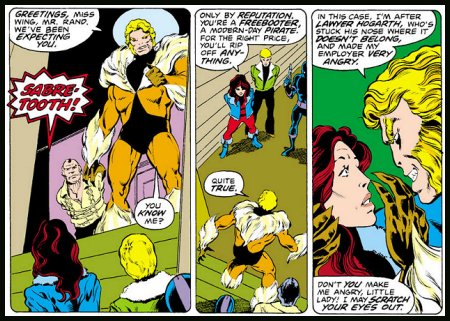
Sabretooth's employer
"What I ultimately was going to establish was that all the Sabretooths we had seen heretofore, with the possible exception of the one in Iron Fist #14, were clones made by Mr. Sinister. They were Xeroxes," Claremont revealed in Wizard Tribute To Wolverine.
However, in Iron Fist #14, 1977, Sabretooth had an employer whose identity has never been revealed. Sabretooth had been hired to stop lawyer Jeryn Hogarth's investigation into who was draining Rand-Meachum of funds. With Mr. Sinister having a retroactive influence in the Marvel universe, it is possible that he could have been Sabretooth's employer, stealing money from Rand-Meachum to finance his clone experiments.
"Sinister's modus operandi was to capture an operative, stick him in a stasis chamber, clone a copy and send that person out to do battle," Claremont revealed in Wizard Tribute To Wolverine. "So you have an inexhaustible supply of Marauders from his clutch of villains."
That explained how Vertigo could be both a Marauder and a Savage Land Mutate at the same time. The Marauder Vertigo was a clone of the Savage Land Vertigo who had escaped Mr. Sinister like the original Sabretooth had.
"In the case of Sabretooth, you had a Xerox of a Xerox," Claremont explained in Wizard Tribute To Wolverine. "That's why the Sabretooth that has always appeared working for Sinister has been so flawed and so easily beaten. We've never seen the real thing. The real thing is quite happy lurking around the fringes of the X-Men universe without any interest whatsoever in the X-Men, but an abiding interest in Wolverine. And Wolverine knows it. But that's one of those unknown stories that'll probably forever remain untold."
In New Mutants #75 from 1989, written by Louise Simonson, it was hinted at that it wasn't the real Sabretooth who had died, but although a clone of Sabretooth appeared in X-Men Vol.2 #34 in 1994, subsequent writers never figured that Sabretooth was ever anything but the real deal. In X-Men Vol.2 #34, writer Fabian Nicieza used the idea that the Marauders were clones, but not that Mr. Sinister kept the originals in storage, only samples of their DNA. In Gambit Vol.3 #8-9 from 1999, Nicieza further stated that, with the exception of Sabretooth, all of the Marauders had been cloned so many times that their original bodies no longer existed.

Created to die
In X-Men #118, 1979, Wolverine met Sunfire's cousin, Mariko Yashida. "Everyone has a vision of Wolverine. What kind of girlfriend would he have?" Claremont asked in Back Issue #4. "You run down a list of possibilities, and with Mariko we basically wanted to trump all those preconceptions and just say, "Ha, ha! This is the girl he chooses to fall in love with: The absolutely, impossibly unattainable vision of purity." It's doomed from the start."
"It was a typical yin-yang, rough and soft thing," Byrne told Back Issue #4. "She was so exactly not right for him that it had to be. And I know she got quite a bit tougher after I left. But she was supposed to be the delicate flower, the porcelain doll that he just instantly falls totally in love with because she's everything that he's not."
"And that's essentially Beauty and the Beast," Claremont added in Back Issue #4.
"Chris suggested she become the housekeeper," Cockrum revealed in The X-Men Companion. "I said, "Chris! She's got housekeepers! She wouldn't become one!"
"Mariko was mine," Byrne claimed in Back Issue #4. "I had just read Shogun, which Chris had not read at that point. I just absolutely wanted to steal that character, just shamelessly steal the character. And as you probably know, she was created to die."
"We kicked around the idea that we'd get into a wedding, they'd say, "I do," Sabretooth would jump out and kill Mariko on the altar and leave, and that would be that," Claremont revealed in Back Issue #4.
"Sabretooth was going to attack her, but she wasn't going to die at his hands," Byrne said to Back Issue #4. "She was going to end up basically brain dead and in a hospital and Wolverine just doesn't believe that she's gone, and Jean links their minds, and he sees that there's nobody there and he pulls the plug on her."
Wolverine would then seek revenge on Sabretooth. "There will be a big fight and (Wolverine) will kill him on camera, and there will be no doubt about it," Byrne told The Comics Journal #57. "And that will be the one instance where because of the way the story is set up I don't think even (Editor-In-Chief Jim) Shooter would be able to object to a good guy killing somebody."
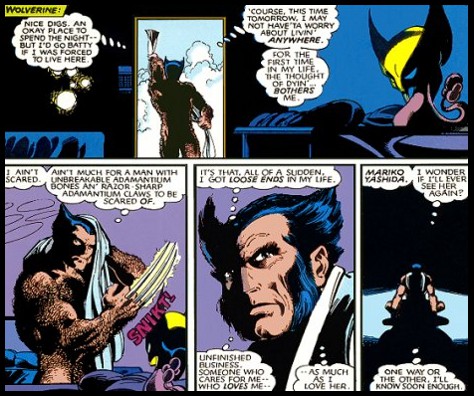
Lethal weapon
"The idea was Wolverine's not like the other X-Men," Claremont told Back Issue #4. "He is, when necessity arises, a stone killer. Nightcrawler is not. Storm is not - she has killed, and it's haunted her ever since. Wolverine, if the need requires it, will go out and kill somebody. End of story. Won't think twice about it. This was a bone of contention with (Editor-In-Chief) Jim Shooter."
"Evidently, John went to a convention and Jim was appalled to hear John saying, "Yeah, Wolverine killed the guard in X-Men #116 (in 1978); yes, Wolverine's a crazy guy; yes, Wolverine will cut people to pieces without a second thought,"" Claremont recalled in The X-Men Companion. "Jim came back to the office and said we must either present Wolverine's victims alive and hale and repaired and unhurt, or Wolverine must pay for his crimes, stand trial and be punished."
"His feeling was, X-Men don't kill, and he wanted us to establish that all the Hellfire guards and the Savage Land guys were still alive somewhere, they were banged up really bad, but he hadn't killed them," Claremont told Back Issue #4. "Whereas I think both John and I felt that it was very important to establish that Wolverine had this inner lethality about him that marked him as different from the rest of the X-Men."
"Shooter was the one who insisted that everyone that Wolverine had ever killed should turn up alive, possibly with bionic parts (which they did in Uncanny X-Men #152, 1981)," Byrne told Back Issue #4. ""Heroes shouldn't kill." I said, "Well, Wolverine isn't really a super-hero, is he? Not in the classic sense, anyway. That was sort of the whole point."
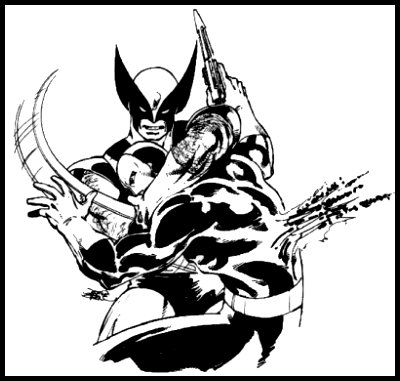
Protecting humanity from Wolverine
"So we began toning Wolverine down, making him more rational, the rationale for this being that he could not have loved Jean, could not have experienced X-Men #137 (1980) and not be changed," Claremont explained in The X-Men Companion. "Wolverine's response was to grow up."
"Then, after we set this process in motion, Jim came in and demanded to know why Wolverine was being turned into a sissy. Evidently, what he wanted was for Wolverine to have the capacity to go crazy and kill but never be allowed to kill. He wanted Wolverine to be as much of a potential danger to the X-Men as to other people. So we turned right around and had Wolverine try and cut Nightcrawler's head off over Mariko (in X-Men #143, 1981), which made no sense whatsoever."
"That's what Shooter wanted, this sense of a time bomb ticking away in the midst of the X-Men," Byrne told The X-Men Companion. "This guy, at any moment, for any reason, could go off, and he wouldn't necessarily kill a villain. He could turn around and deck Nightcrawler just for something to do."
"When he attacked Nightcrawler for kissing Mariko under the mistletoe (in X-Men #143)... Come on, he knows these people are friends; he's not going to do that," Cockrum opinionated in The X-Men Companion. "I mean, that was no menace. That was apparently done on Shooter's orders, "Make Wolverine do something crazy." Personally, I think that was a bad choice. That's all inconsistent with what they've done with him."
"The whole notion of Wolverine in my head was that the only reason he was in the X-Men was so he could be controlled," Byrne said in Back Issue #4. "Xavier had brought him in more or less to keep an eye on him."
"The X-Men are taking the role of the Wolverine's guardian," Byrne added in The X-Men Companion. "Their role is not only to protect the X-Men from humanity; it is also to protect humanity from the X-Men."
Dark Wolverine
"Wolverine is surrounded by a very specific set of parameters, stay within those parameters, you're fine," Claremont stated in The X-Men Companion. "But if you cross the line, you have to be prepared to take the consequences, like a rude word, or a punch in the nose, or you can have your guts cut out. It depends on the gravity of the transgression."
"The definitive Wolverine sequence is he's sitting at the breakfast table, eating a bowl of cereal, and Kitty comes in and says, "Hi!" in exactly the wrong tone of voice, and Cyclops comes in, and there's Wolverine eating his breakfast cereal, and Kitty lying on the floor disembowelled," Byrne told Back Issue #4.
"So everyone around him had to be on their best behaviour and on their toes because you never know when you might end up with Dark Wolverine," Claremont added in Back Issue #4.
"I think a lot of that comes from his upbringing, from having Sabretooth as his father," John Byrne told The X-Men Companion. "I would think that this is an abused child like nobody's been before. I think that along came World War II and he was told, "Go out and kill," and he discovered that he could send a great deal of his angst that way."
Byrne's unused adamantium theory
"Early on, Chris said that Wolverine had mutated these claws, which were biological adamantium," Byrne revealed in The X-Men Companion. "When I got up off the floor, I said, "No, this is what happened." And what I conceived of was that his power is total regeneration, except it didn't work on his bones. One day he was in a tremendous accident and every bone in his body got broken, and everything regenerated except that when he got up out of bed, his weight broke his legs. And they realised that whatever it was he had didn't work on the calcium-based bones or whatever excuse you want to use."
"This happened a long time ago well, just after the war and it was some twenty odd years, or longer, as Marvel time goes, before James Hudson (Vindicator) found him. So I figured that Wolverine was a basket case, basically. Terribly crippled, in a wheelchair, body brace, the whole thing, living out in the woods as much by himself as he could and just becoming more and more bitter over the years."
"Then Vindicator came along and said, "Listen, the way your body heals, we can do something we can't do with any other human being. That is, we can remove each of your bones individually, cast them in adamantium and replace them," and that's what they did - a very long and probably painful process. They removed every one of his bones, except the spinal column and the skull, which they reinforced. And as for the question, "Where do the red blood cells come from?" which everybody hits me with, his power is total regeneration and his red blood cells don't wear out, so he doesn't need new ones."
Sources:
Tom DeFalco: Comics Creators On X-Men, April 2006
Michael Eury: "I Was A Teenage Wolverine!", Back Issue #4, June 2004
Mitch Itkowitz and others: "John Byrne", The Comics Journal #57, 1980
Peter Sanderson: The X-Men Companion I, March 1982
Peter Sanderson: The X-Men Companion II, September 1982
Peter Sanderson: "Pro 2 Pro Claremont And Byrne: Wolverine At 30", Back Issue #4, June 2004
Wizard Tribute To Wolverine, 1996
